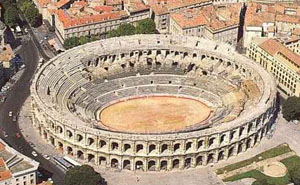Féria, Narbonne: three days in Spring, five days at Pentecost
(Whitsun, June), and three days on the third weekend in
September. All with daily corridas (bullfighting).

 The
typically Spanish Form of Bull Fighting.
The
typically Spanish Form of Bull Fighting. Bull fighting
is associated with Spain. It is popular there - with several
thousand Spaniards going to bull-rings each week. It is said
that one million Spaniards watch bullfights every year. Spanish
bullfighting traces its modern origins to 711 A.D. In that
year a bullfight took place to celebrate the coronation of
King Alfonso VIII. Bullfighting was originally a sport for
the aristocracy and took place on horseback.
King Felipe V took exception to the sport and banned the
aristocracy from taking part, believing it to be a bad example
to everyone else. After the ban, around 1724, commoners
adopted the sport as their own and, since they did not have
horses, developed the practice of dodging the bulls on foot,
unarmed.
In a modern Spanish bullfight the bull is let into the
ring. A bullfighter called the Matador watches as an assistant
waves a yellow and magenta cape in front of the bull to
encourage it to charge. The Matador watches to determine
the bull's qualities and mood, before taking over himself.
A trumpet is sounded and other bull fighters (Picadores)
weaken the bull by placing spears into it. This phase takes
around 10 minutes, after which another trumpet is sounded
and the Matador removes his black winged hat (strangely
redolent of Mickey Mouses's ears) and dedicates the death
of the bull to the president - or to the crowd - before
beginning his faena.
The faena is regarded as the most artistic and skilled
phase of the fight, where the matador proves his courage
and artistry. The bull charges the Matador who carries a
muleta. The muleta is a piece of thick crimson cloth draped
over a short stick (held in either the left hand) or else
over the killing sword or espada (which is invariably held
in the right hand).
It is the Matador's job to create a dramatic show enjoyable
for the audience. The faena continues until the Matador
has demonstrated his mastery of the bull and the bull is
ready to be killed. The matador now stands around ten feet
away from the bull, keeping the animal's attention fixed
on the muleta. He aims the espada between the bull's shoulder
blades. Approaching the animal he thrusts forward, over
the bull's horns, pushing the espada deep between the animal's
shoulder blades. If the sword goes in to the hilt it is
an estocada, which results in the bull dropping immediately
to its knees and dying.
If the sword hits bone it is a pinchazo or media-estocada.
If the bull fails to die the matador may use a sword with
a short cross piece at the end (a descabello) which he stabs
into the bull's neck severing the spinal cord.
According to his skill in killing the bull, and the show
he has put on for the crowd, the matador may be awarded
trophies by the president. Trophies can be one or two ears
from the bull, the tail and the hooves. The crowd may encourage
the president to award trophies by waving white handkerchiefs.
This waving may continue after trophies have been awarded
in an attempt to induce the matador to cast his trophies
into the crowd. The crowd in return throws flowers into
the arena which are collected by the matador's assistants.
It is almost indistinguishable from scenes throughout the
Roman Empire two thousand years ago.

![]()

![]() Here's
a question. When did the ancient Roman practice of holding
animal games in amphitheatres die out. Answer: They never
died out completely. Bullfights are almost unchanged since
Roman times. All the features are there. Fierce dangerous
animals facing professional gladiators and other animals
(in this case horses). A fight to the death, set up as public
show in a roman arena (or a modern reproduction of one).
The musical band, the ritual, the crown participation, the
president of the games - these are all features preserved
from Roman times.
Here's
a question. When did the ancient Roman practice of holding
animal games in amphitheatres die out. Answer: They never
died out completely. Bullfights are almost unchanged since
Roman times. All the features are there. Fierce dangerous
animals facing professional gladiators and other animals
(in this case horses). A fight to the death, set up as public
show in a roman arena (or a modern reproduction of one).
The musical band, the ritual, the crown participation, the
president of the games - these are all features preserved
from Roman times.
![]() Bullfighting
is often thought of a specifically Spanish, but it is not.
Much of what we now call the South of France was long an
independent state - or patchwork of states - where different
traditions flourished. In recent years these traditions
have found new strength, and bull running and bull fighting
is flourishing throughout the Midi, and especially in the
Languedoc.
Bullfighting
is often thought of a specifically Spanish, but it is not.
Much of what we now call the South of France was long an
independent state - or patchwork of states - where different
traditions flourished. In recent years these traditions
have found new strength, and bull running and bull fighting
is flourishing throughout the Midi, and especially in the
Languedoc.






